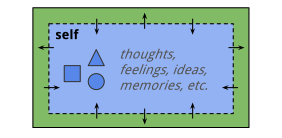The actor has a constant problem of personal identity. — Cyril Cusack
Ethology is the study of animal behavior, and humans, of course, are 'just' a special sort of animal. We are a social and political species — competitive and cooperative, highly communicative, and more or less self-aware.
Given the kind of creatures we are and how we interact with each other, identity turns out to be largely a social phenomenon. So you might say this is an essay about social identity.
Identity is traditionally framed as metaphysics. "Who am I really? What is the essence of my being?" These questions are important, certainly, but metaphysics is subtle and tricky and excruciatingly abstract, and quite frankly it bores me. I'd much rather talk about behavior.
But first let's establish some metaphysical ground rules, very briefly, as a point of departure. Who am I really? I am a mind produced by a brain — a pattern of neurons animated by the energy flowing through them. Everything that 'I' am is dancing around in a lump of grey jello inside my skull. That jello is home to all my thoughts, feelings, ideas, experiences, habits, skills, and memories. At the end of the day, those are what matter to me.
</metaphysics>
Now the brain interacts in all sorts of ways with the external world, and every interaction changes it in some way. Let's explore some of those interactions and how they shape our identities.
Inhabitance
When you think about 'the self' interacting with the external world, what do you picture?
For a long time, this was my mental model:

According to this image of the self, we relate to the external world by absorbing information about it (perception) and by using certain objects as tools (manipulation).
For the most part, these relationships don't have a big effect on who we are. The closest we get to incorporating a tool into our identity is when we treat it as an extension of our bodies. (Ex-tend: to stretch out. In-corporate: to bring within the body.) Like a brush to a painter, guitar to a musician, or surfboard to a surfer. Or smartphones to the 21st century digerati.
But there's another, more important way we relate to external objects: by inhabiting them:

Inhabitance may not strike you as particularly interesting or special, but it is. It's a far richer relationship, with higher-bandwidth feedback, than the relationship we have to objects that we merely perceive or manipulate. And our brains have a unique way of processing inhabitance, as we'll see.
To give you a feel for what I'm talking about, here are some of the things we can be said to inhabit:
- Our bodies
- Clothes, cars, and houses
- Communities, roles, and occupations
- Habitats and niches
- Stories (think of how much time you spent living inside the last novel you read)
- Music and dance (especially when you're actively involved)
- Other people's minds, via empathy
- Ideas, perspectives, and worldviews
The inhabitance diagram (above) isn't meant to be precise, but it is meant to be evocative. And one of the ideas it evokes is that our containers (the things we inhabit) exert pressure on us. They push and pull on our identities in characteristic ways.
If you've ever worn clothes that didn't 'fit' with your self-image, you'll know what I mean. Same goes if you've worked in a role that felt 'too big' or 'too small' for you, or otherwise made you uncomfortable.
Bodies, clothes, cars, and houses
In-habit: to dwell inside. Make a home. Live within.
Some of the things we inhabit are metaphorical, but many are plainly, powerfully physical. Among these are bodies, clothes, cars, and houses.
If you harbor any doubt that these are absolutely critical to our sense of identity, look no further than the vanity and anxiety with which we attend to them. The countless hours spent preening and cleaning, dusting and adjusting, trying and buying, tending and mending. The time, effort, and income we spend painting our houses and faces. Waxing our legs and our windshields. Straightening our shirts, living rooms, and teeth. Spritzing perfumes and air fresheners.
Cosmetics is a $230 billion industry, and that's just a tiny fraction of the 'vanity industry.' We spend literally trillions of dollars a year tending to each and every facet of our public image.
If bodies, clothes, cars, and houses consume so much of our attention and disposable income — and income we haven't even earned yet [sad face] — it's because they can be tweaked, endlessly, to potential perfection. Money can't buy you love, but it can help you look and feel like a rockstar. Even on credit.
I find it interesting that my brain knows how to treat a car as an extension of its body. I instinctively flinch when I'm about to hit a pothole, for example, and I've even learned to read the nonverbal 'language' of other cars on the road. This "autobody language" (forgive the pun) isn't particularly rich or nuanced, but there are enough subtle movements to indicate when another car sees me, or when it's about to change lanes. And this effect is even stronger, I'm told, for those who ride motorcycles.
Communities, roles, and occupations
In addition to the things we inhabit physically (bodies etc.), there are a number of equally important things we inhabit metaphorically. Among these are communities (which we live in), roles (which we fill), and occupations (which we, um, occupy).
These are a core part of any capsule biography — like the ones given when introducing a speaker, on 'About Us' web pages, and in the first sentence of any Wikipedia bio page. The community + role construction, in particular, fits the genus-differentia pattern: first, orient the subject you're trying to define within a genus (family), then provide its differentiating characteristics.
What communities, roles, and occupations lack in physicality, they more than make up for in social and political significance. Which communities you belong to, your place within them, and how you make a living are some of the most socially salient facts about you. Perhaps this is because, unlike clothes and cars, these things signal who your allies are.
They're so important we even take them to our graves:
Internalizing our containers
Inhabitance is powerful because the things you inhabit are part of your projected social presence. Wherever you go, you bring your containers with you; they participate in all your social interactions. And this is true of the things you wear metaphorically as well as physically. From the perspective of others, the containers you inhabit are just part of who you are — the whole package, as it were.
We often lament this identification with external 'surface' characteristics. Beauty is only skin deep, we say. It's what's on the inside that counts. But we should be forgiven this fixation with the surface, I think, because it's just so prominent, and what's inside nearly invisible.
But it gets worse.
The things we inhabit have an uncanny way of working their way 'inside' — of becoming part of our core, inner, metaphysical selves. We don't just wear our clothes and play our roles: we internalize and become them.
This is the result of at least three processes: facial feedback, bodily feedback, and social feedback. Let's discuss each of them in turn.
Facial feedback
In his 1872 book The Expression of the Emotions in Man and Animals, Darwin wrote:
The free expression by outward signs of an emotion intensifies it.
That is to say: Making faces can enhance (or even trigger) emotions.
This has come to be known as the facial feedback hypothesis, and it's been demonstrated in a number of clever studies. Subjects who were asked, for example, to clench a pen between their teeth (inducing a smile) found a cartoon funnier than those who were asked to hold the pen between their lips (inducing a frown) (ref). [Update 2016/08/25: This result has since failed a serious replication attempt.] Subjects who were manipulated into furrowing their brows reported feeling sadder when looking at sad photos (ref).
In other words, the causation runs 'inwards' as well as 'outwards.' Our faces don't simply express what we feel inside. (Ex-press: to push out.) To some extent, we also feel what's on our faces.
Bodily feedback
By analogy with the facial feedback hypothesis, we might also propose a "bodily feedback hypothesis." There's no Wikipedia page for it and only a few references on Google Scholar, but the idea is just a generalization of what happens with our faces.
I've written about this before. In Minds, Bodies, and Rituals, I said:
What we do with our bodies can change how our minds think, feel, and perceive.
It may sound like I’m making some New Age-y claim, but I’m not. I’m just pointing out that specific physical actions, often even small and simple ones, can influence our thoughts, feelings, and perceptions of the world around us.
Dancing makes us feel happy. Bowing makes us feel submissive. Good posture and breathing give us confidence.
This is no small effect. It's happening everywhere and all the time.
Keith Johnstone understands this on a very practical level. In Impro, his guide to improvisation in the theater, he devotes at least two chapters to exploring these body-to-mind effects. My favorite example is how speaking-with-a-still-head gives you an instant feeling and aura of high status:
Keeping my head still whenever I speak... produces great changes in the way I perceive myself and am perceived by others.... Actors needing authority — tragic heroes and so on — have to learn this still head trick. You can talk and waggle your head about if you play the gravedigger, but not if you play Hamlet. Officers are trained not to move the head while issuing commands....
If I speak with a still head, then I'll do many other high-status things quite automatically. I'll speak in complete sentences, I'll hold eye contact. I'll move more smoothly, and occupy more 'space'.
And on the other hand:
If I talk with my toes pointing inwards I'm more likely to give a hesitant little 'er' before each sentence, and I'll smile with my teeth covering my bottom lip, and I'll sound a little breathless, and so on. [My students and I] were amazed to find that apparently unrelated things could so strongly influence each other; it didn't seem reasonable that the position of the feet could influence sentence structure and eye contact, but it is so.
We would experience these effects even if other people didn't perceive and treat us differently based on our behavior. But of course they do.
Social feedback
If the facial feedback hypothesis says that we internalize what we express on our faces, and the bodily feedback hypothesis says that we internalize our own body language, then the "social feedback hypothesis" says that:
We internalize how we are treated by others.
I don't know if this is controversial, but it's extremely important.
Consider: why do politicians lie so much?
Trick question, they don't. Well, maybe here and there. But for the most part — and for the biggest lies — they actually believe what they're saying.
By the nature of their position, they're forced to play a role. The role requires them to do and say certain things (even things of questionable veracity). They play this role every minute of every hour of every day. And it's reinforced by everyone around them. Their staff, their constituents, and even the media expect them to play the role — to speak and behave in ways that are consistent with it. If they break character, even for a split second, the effects can be career-killing.
Faced with these incentives, the only option for politicians is to become the role. To internalize it, make it part of who they really are. The sad miracle of this is that it lets them speak authentically and passionately about things that are patently ridiculous. But they aren't lying, because they really believe what they're saying.
Of course it's not just politicians who face these incentives (theirs is just the most extreme and pathological case). We all have a tendency to internalize the roles we play.
Masks and persons
If you wear a mask long enough, it ceases to be a mask. By way of feedback (facial, bodily, social), it becomes part of who you are.
Here's a jaw-dropping piece of etymology: our word person comes from the Latin word for mask.
That's right. Per (through) + sona (sound). The thing worn on stage, through which an actor's voice is transmitted.
How's that for the relationship between identity and inhabitance?
"Clothes make the man"
I hear this a lot. And until recently, I understood it in strictly Machiavellian terms: Because clothes are socially significant (i.e., to other people), you have to dress well in order to get ahead.
But now that I understand how we internalize things, I think it goes a lot deeper. Clothes don't change just how you're perceived by others — they change your own sense of self.
You are what you eat: this is simple chemistry. Less understood, but more important, is that you become what you wear.
Consider:
- When wearing a suit and tie, it's much harder to make unseemly body movements. You can't waggle your head when it's held in place with a stiff collar.
- Walking around in heels forces you to move more slowly, carefully, and with better (or at least different) posture.
- People treat you differently whether you wear shiny or shabby clothes. And because of how your brain is wired to process social feedback, you can't help but pick up on this and incorporate it into your self-image.
This is happening even (or perhaps especially) when you're not conscious of it. Unless you're extremely self-aware, it's hard to disentangle the effects of what you're wearing from who you 'really' are. (Maybe because there's less of a distinction than we like to believe.)
Say you're in a meeting. If people listen attentively and respond to your ideas, how can you tell what they're reacting to? Maybe you have relevant things to say. Maybe you're naturally charming and charismatic. Maybe you have some power over the others in the room. Or maybe you're just wearing clothes that command respect, and everyone is responding to your outfit. The point is, it doesn't matter. Whatever the reason, they're responding to you (your entire projected social presence, clothes and all) in predictable ways. In light of this, it's very reasonable for your brain to adjust its self-image, without bothering to over-analyze.
Actors intuitively understand this, as Keith Johnstone again demonstrates:
Someone wears a boiler suit stuffed with balloons to make him 'huge'.... I say, 'Move and imagine that the costume is your body surface', and suddenly he becomes a 'fat man'. Pretending that the costume is the actual body surface has a powerful transforming effect on most people.
In a similar vein, here's Charlie Chaplain describing the birth of his famous Tramp character:
On the way to the wardrobe I thought I would dress in baggy pants, big shoes, and a cane and a derby hat. I wanted everything to be a contradiction; the pants baggy, the coat tight, the hat small and the shoes large.... I had no idea of the character. But the moment I was dressed, the clothes and make-up made me feel the kind of person he was. I began to know him, and by the time I walked on the stage he was fully born.... My character was different and unfamiliar to the Americans. But with the clothes on I felt he was a reality, a living person. In fact he ignited all sorts of crazy ideas that I would never have dreamt of until I was dressed and made-up as the Tramp.
Shape prejudice
Another dramatic example of social and bodily feedback comes from an essay by David Deutsch on how we treat children.
Deutsch describes in some detail an episode of Star Trek: The Next Generation in which the captain is accidentally transported into the body of a child. Although the crew recognizes the captain as the same person he was before the transformation, they find they can't help but treat him differently.
"What is going on here?" Deutsch asks:
The Captain of a Starship is not being taken seriously by his own subordinates. Why? Whatever the reason is, it must be very powerful if it takes precedence over these people's loyalty, their training, their personal respect and admiration for Picard — to say nothing of elementary decency and commonsense! For when it comes down to it, nothing of any significance has really changed.
The Captain has merely changed shape.
As the episode shows, the Captain even finds it hard to take himself seriously in this new body.
Ecology and personal identity
I'll have more to say about this in a later essay, but for now I'll just toss out one final idea:
Personality is an adaptation to a social niche.
Who we are, in other words, is the result of a ongoing negotiation between our intrinsic qualities and the external, social world — the same way a species is the result of a negotiation between its inherited gene pool and the niche it inhabits.
In the nature vs. nurture debate, everyone knows it's not one or the other, but some 'mixture' or interaction between the two. This is my proposal for what that interaction is. Nature negotiates with nurture, and the resulting territory determines who we are.
___
Thanks to Diana Huang for reading a draft of this essay.
 Melting Asphalt
Melting Asphalt


